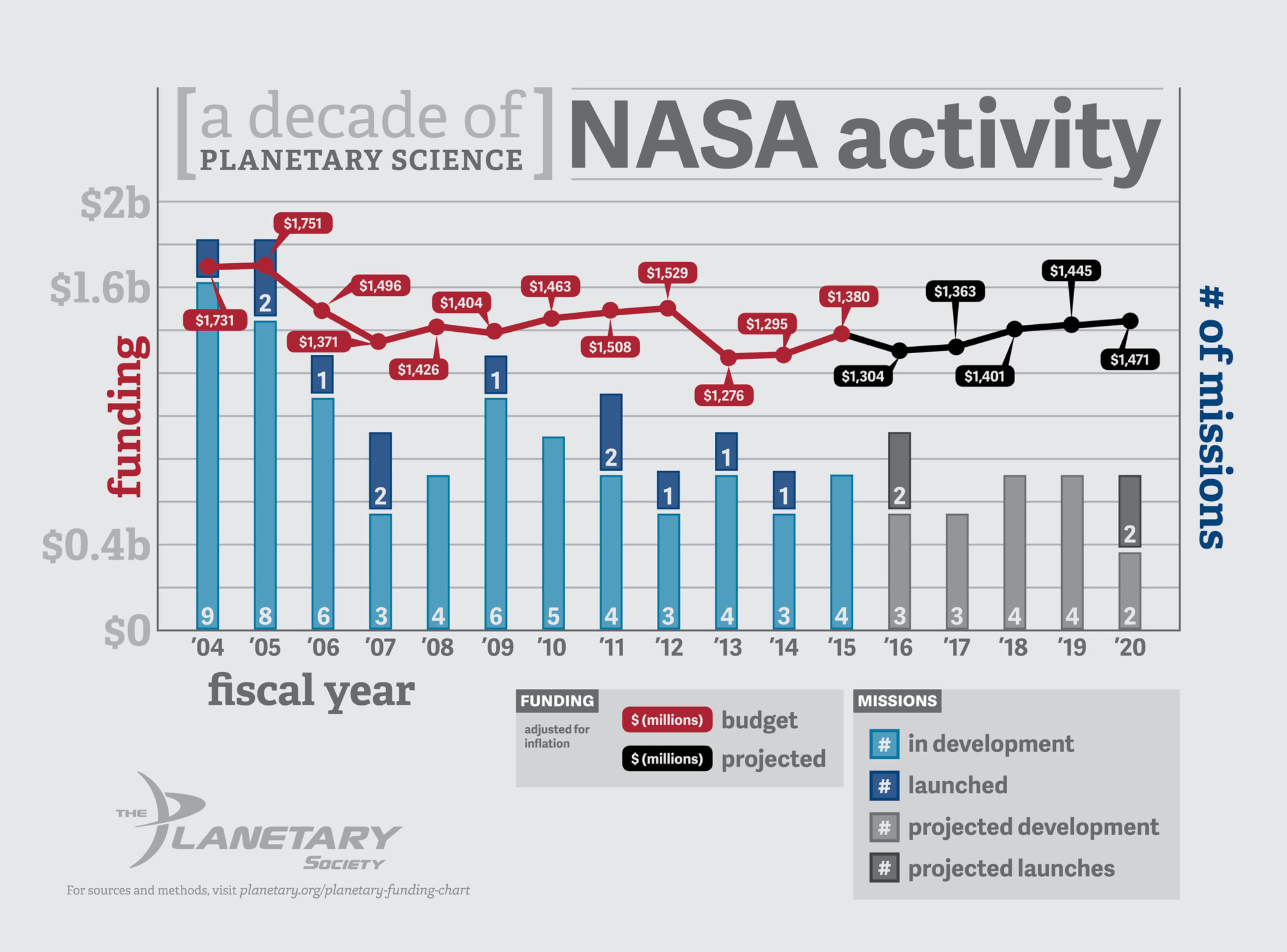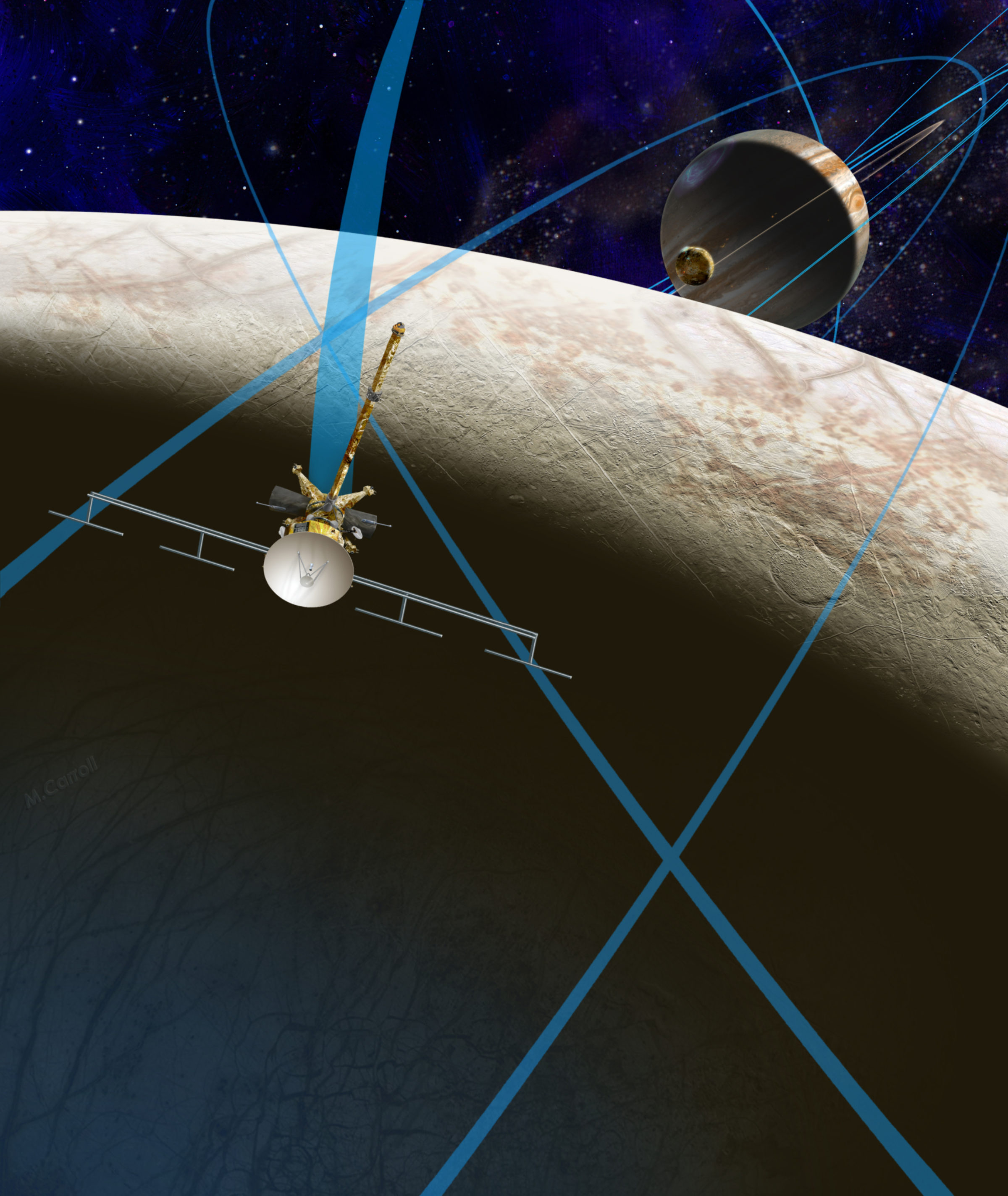The Planetary Society’s Statement on the FY2015 NASA Budget Request
NASA deserves a budget that protects its current and future science goals. This is not it.
For Immediate Release
March 13, 2014
Contact
Casey Dreier
Email: [email protected]
Phone: +1-626-793-5100
The Planetary Society cannot fully support the FY2015 NASA Budget Request. While there are some positive aspects—particularly the newfound openness to exploring Europa and the continued science operations of most high-priority planetary missions—the request imposes unacceptable cuts to the Science Mission Directorate that damage the immediate and long-term health of some of NASA's most successful programs, particularly planetary exploration. If this budget is passed unchanged, there will be fewer planetary missions in development by 2019 than at any point in the past few decades (Fig. 1).
"Planetary science is what NASA does best right now," said Planetary Society CEO Bill Nye. "It's where we get the greatest return on our investment, because the engineers and scientists are solving new problems, exploring new places, and making new discoveries. It drives innovation, which in turn drives our economy like no other. This is not where we should be pulling back."
The White House and its Office of Management and Budget have continued their assault on NASA's Planetary Science Division, requesting cuts to the program for the third year in a row despite consistent opposition from Congress, the scientific community, and the public. Though the proposed cuts in FY2015 are smaller than in recent years, they still represent a loss of over $200 million from the Division's historical average, and would ensure the continued decline of NASA's planetary exploration program through the decade.
We once again urge Congress to restore funding for planetary science to its historical average of $1.5 billion to maintain a balanced program of small missions, Mars exploration, and a major scientific mission to Europa.

"There is serious cause for concern if not outright alarm," said Planetary Society President Dr. Jim Bell. "While the Administration's request for planetary science includes some steps in the right direction, we are concerned with the lack of future funding for Opportunity, which continues to perform outstanding science on the Red Planet, the lack of funding for LRO (Lunar Reconnaissance Orbiter), which is providing key measurements needed for the future exploration of the Moon, and the lack of funding for the SOFIA (Stratospheric Observatory for Infrared Astronomy) airborne observatory in Astrophysics, which has only recently begun full science operations and which can make important contributions to solar system and extrasolar planetary astronomy."
In addition to cuts to planetary science, the White House proposes cuts throughout NASA, including a $186 million cut to the agency's total budget, a $179 million cut to the Science Mission Directorate, a $61 million cut to Astrophysics, a $56 million cut to Earth Science, and a $27 million cut to the Office of Education. These cuts endanger still-productive missions by placing their funding in the supplemental Opportunity, Growth, and Security Initiative (OGSI) and not the actual budget request. They also indefinitely delay the next medium-class "New Frontiers" planetary mission and make continued operations of the SOFIA airborne telescope contingent on funding from our international partners.
However, The Planetary Society was very pleased to see Europa mentioned in the FY2015 request. After last year's discovery of water plumes erupting from Europa's south pole, we called on NASA and the White House to embrace a new mission to explore this compelling destination. To sample Europa's water, a spacecraft could simply fly through these plumes instead of landing and drilling through the moon's icy crust, greatly reducing the complexity of this first analysis. "The Administration's acknowledgement of the importance of a new mission to Europa is encouraging," said Bell, "but the specific funding to be allocated would represent only tentative steps."

The budget request projects no funding for a Europa mission beyond 2015, though statements made by NASA leadership suggest they are pursuing one with a cost-cap of $1 billion—less than half the estimate of the already reduced-cost "Clipper" concept. This approach raises questions about adequate scientific return from such a cost-constrained mission. Now that NASA and the White House have accepted the importance of exploring Europa, we strongly urge them to pursue a mission that achieves a preponderance of the scientific goals as laid out in the National Research Council's 2011 "Visions and Voyages" decadal survey report. The Planetary Society looks forward to the results from the upcoming Request For Information on a reduced-cost concept to see if these science goals can be preserved.
The Society strongly supports the budget request's continued funding for most active planetary science missions, including both the Mars Science Laboratory Curiosity rover and the Cassini Saturn orbiter. The proposed budget does include a more realistic funding profile for the Mars 2020 sample-caching rover, helping to ensure that this mission remains on-budget and on time.
We were also pleased to see increased funding for the Commercial Crew program, which could help to provide new technologies and opportunities for space science and exploration; steady funding for the James Webb Space Telescope, which will acquire important new solar system science data sets; and the InSight mission to Mars, which would provide the first measurements of the level of seismic activity of the Red Planet's interior. NASA's Asteroid Initiative provides crucial funding for near-Earth object detection, though we look forward to learning more details about the asteroid capture and redirect mission.
FY2015 will be another historic year for planetary exploration: the New Frontiers-class New Horizons mission will fly by Pluto; the Discovery-class Dawn mission will orbit Ceres, the asteroid belt's largest object; and the flagship-class Curiosity rover will reach the base of Mt. Sharp, a 5 km-tall Martian mountain. These are true feats of exploration, and all of them were initiated by the previous Presidential administration. There is still time for this administration to leave its own positive legacy.
But right now the Obama White House is bequeathing a deeply troubled future of planetary exploration to its successors. Its FY2015 budget does not preserve a healthy program. As the current slate of missions reach the end of their lives, there are few ready to take their place exploring the solar system. We urge Congress to once again reject these cuts to NASA's Planetary Science Division, as well as to NASA's top-line and to the Science Mission Directorate. We urge Congress to, at the very minimum, preserve NASA's funding at FY14 levels and to restore planetary science to its historical average of $1.5 billion per year.
About The Planetary Society
With a global community of more than 2 million space enthusiasts, The Planetary Society is the world’s largest and most influential space advocacy organization. Founded in 1980 by Carl Sagan, Bruce Murray, and Louis Friedman and today led by CEO Bill Nye, we empower the public to take a meaningful role in advancing space exploration through advocacy, education outreach, scientific innovation, and global collaboration. Together with our members and supporters, we’re on a mission to explore worlds, find life off Earth, and protect our planet from dangerous asteroids. To learn more, visit www.planetary.org.
###


 Explore Worlds
Explore Worlds Find Life
Find Life Defend Earth
Defend Earth

